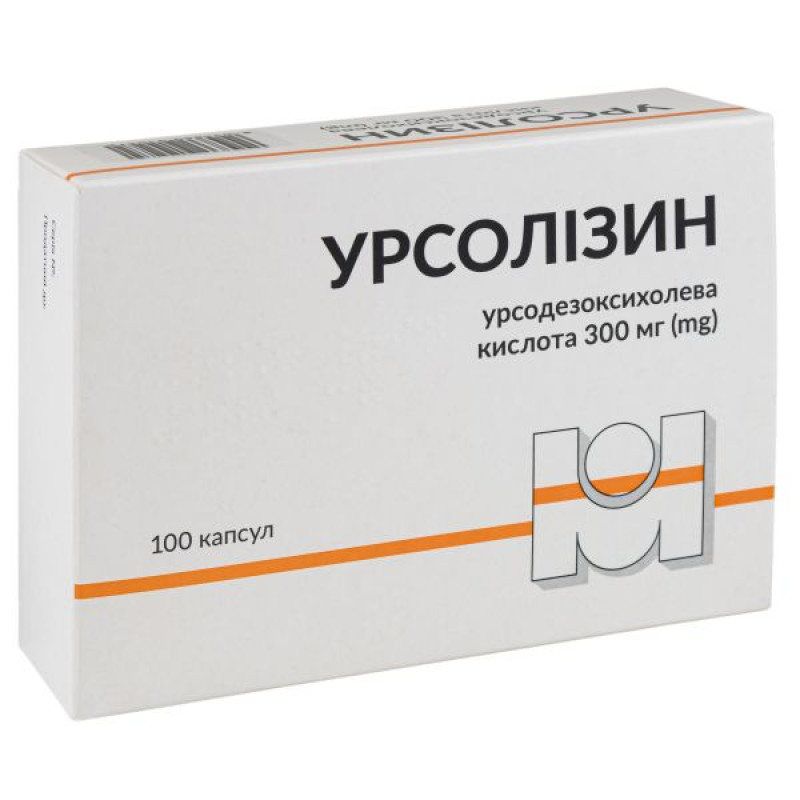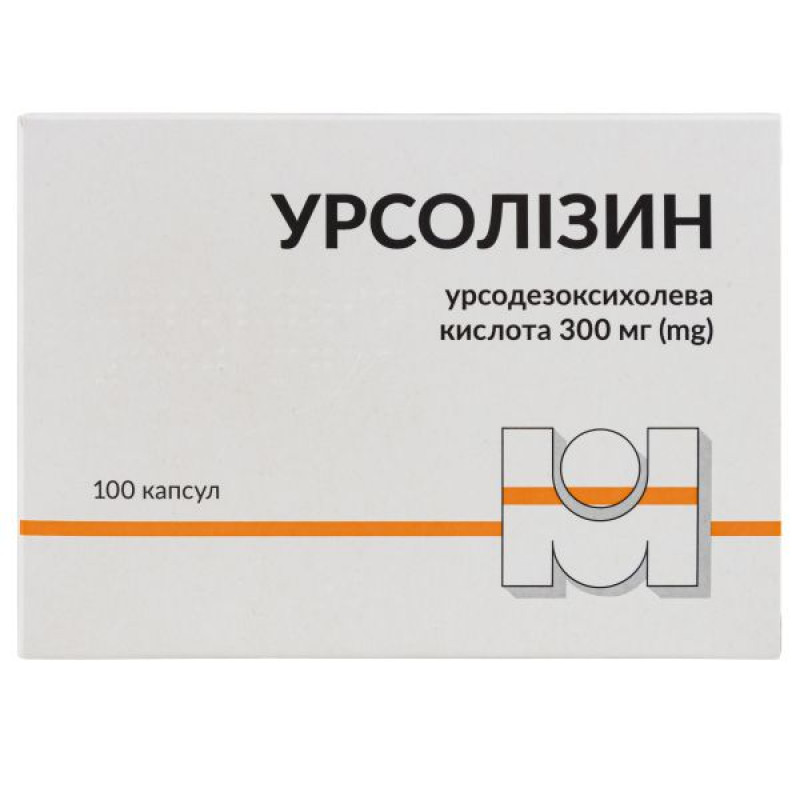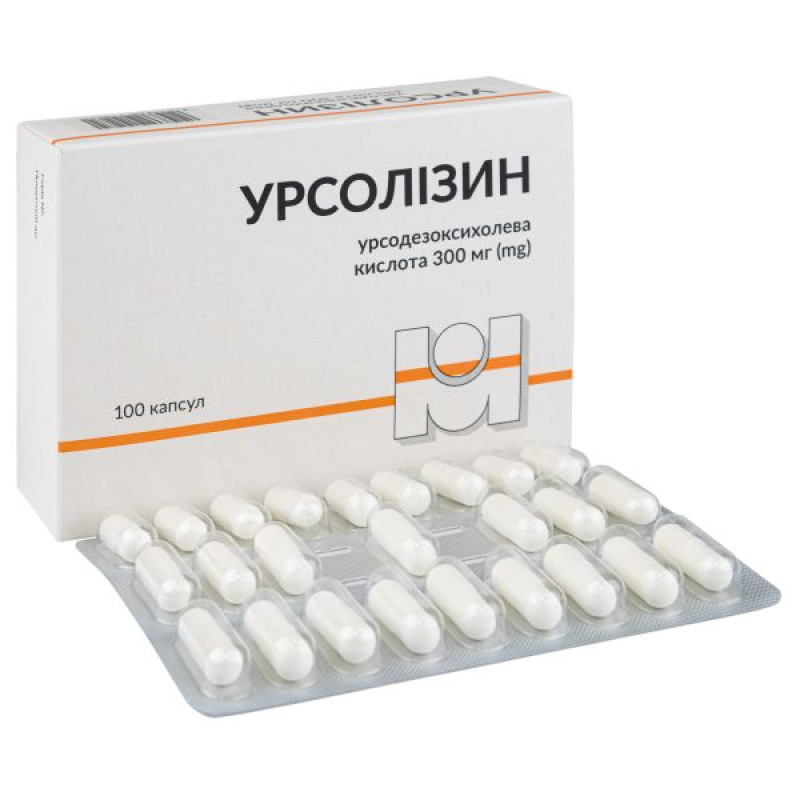Ursolisin capsules 300 mg No. 100

Instructions for Ursolisin capsules 300 mg No. 100
Composition
active ingredient: ursodeoxycholic acid;
1 capsule contains 150 mg or 300 mg of ursodeoxycholic acid;
excipients: corn starch, magnesium stearate, colloidal anhydrous silicon dioxide, gelatin, titanium dioxide (E 171).
Dosage form
Capsules.
Main physicochemical properties: white hard gelatin capsules containing white powder (conglomerates may form during storage).
Pharmacotherapeutic group
Drugs used in diseases of the liver and biliary tract. Drugs used in biliary pathology.
ATX code A05A A02.
Pharmacological properties
Pharmacodynamics.
The active substance of the drug ursodeoxycholic acid is a bile acid that is physiologically present in human bile in the form of cholic or chenodeoxycholic acids. After oral administration, ursodeoxycholic acid reduces the cholesterol saturation of bile, preventing its absorption in the intestine and reducing the secretion of cholesterol into the bile. It is believed that the dissolution of gallstones occurs due to the dispersion of cholesterol and the formation of liquid crystals.
The effect of ursodeoxycholic acid in liver diseases and cholestasis is believed to be due to the relative replacement of lipophilic, detergent-like toxic bile acids with hydrophilic cytoprotective non-toxic ursodeoxycholic acid, as well as to the improvement of the secretory capacity of hepatocytes and immunoregulatory processes.
Pharmacokinetics.
After oral administration, ursodeoxycholic acid is rapidly absorbed in the jejunum and upper ileum by passive transport and in the terminal ileum by active transport. After absorption, ursodeoxycholic acid undergoes almost complete conjugation with glycine and taurine in the liver and is then excreted in the bile. The first-pass clearance through the liver is approximately 60%.
Under the influence of intestinal bacteria, ursodeoxycholic acid is partially degraded to 7-ketolithocholic and lithocholic acids. Lithocholic acid is hepatotoxic and causes damage to the liver parenchyma in some animal species. In humans, only a small amount is absorbed, which is sulfated in the liver and thus detoxified, after which it is excreted in the bile and feces.
The biological half-life of ursodeoxycholic acid is 3.5-5.8 days.
Indication
Dissolution of radiopaque cholesterol gallstones no larger than 15 mm in diameter in patients with a functioning gallbladder, despite the presence of gallstone(s).
Treatment of biliary reflux gastritis.
Symptomatic treatment of primary biliary cirrhosis (PBC) in the absence of decompensated liver cirrhosis.
Contraindication
Hypersensitivity to bile acids or to any of the ingredients of the medicinal product.
Acute inflammation of the gallbladder or bile ducts.
Bile duct obstruction (blockage of the common bile duct or gallbladder duct).
Frequent episodes of biliary colic.
Radiopaque calcified gallbladder stones.
Violation of gallbladder contractility.
Interaction with other medicinal products and other types of interactions
The drug should not be used simultaneously with cholestyramine, colestipol or antacids containing aluminum hydroxide and/or aluminum oxide (smectite), since these drugs bind ursodeoxycholic acid in the intestine and thus slow down its absorption and reduce its effectiveness. If the use of drugs containing one of the above substances is necessary, they should be taken at least 2 hours before or after taking ursodeoxycholic acid.
Ursodeoxycholic acid preparations may increase the absorption of cyclosporine from the intestine. Therefore, in patients taking cyclosporine, it is necessary to monitor the concentration of this substance in the blood and adjust the dose of cyclosporine if necessary.
In some cases, ursodeoxycholic acid may reduce the absorption of ciprofloxacin.
In a clinical study in healthy volunteers, concomitant administration of ursodeoxycholic acid (500 mg/day) and rosuvastatin (20 mg/day) resulted in a slight increase in rosuvastatin plasma levels. The clinical significance of this interaction and similar interactions with other statins is unknown.
Ursodeoxycholic acid has been shown to reduce the maximum plasma concentrations (Cmax) and area under the curve (AUC) of the calcium antagonist nitrendipine. It is recommended that the effects of concomitant administration of nitrendipine and ursodeoxycholic acid be carefully monitored.
In addition, an interaction with dapsone has been reported, resulting in a decrease in the therapeutic effect of the latter.
Estrogens and drugs that lower serum cholesterol levels, such as clofibrate, may promote the formation of gallstones and thus reduce the effectiveness of ursodeoxycholic acid when used to dissolve gallstones.
Application features
The drug should be used under the supervision of a physician.
During the first 3 months of treatment, liver function parameters AST, ALT and gamma-GT should be checked every 4 weeks and every 3 months during further treatment. This will not only identify patients with primary biliary cirrhosis (PBC) who respond to treatment with the drug, but also allow for early diagnosis of possible liver damage, especially in patients with primary biliary cirrhosis in the later stages of the disease.
Dissolving cholesterol gallstones.
To assess the therapeutic effect and timely detection of gallstone calcification, depending on the size of the stone, visualization of the general appearance of the gallbladder (oral cholecystography) and possible duct occlusion in the standing and supine positions (ultrasound examination) should be performed 6-10 months after the start of treatment.
The drug should not be used if the gallbladder cannot be visualized or in cases of calcification of stones, impaired gallbladder contractility, or frequent biliary colic.
Women taking Ursolysin to dissolve gallstones should use effective non-hormonal contraceptive measures, as hormonal contraceptives may contribute to the formation of gallstones.
Treatment of primary biliary cirrhosis in the later stages of the disease.
Very rarely, cases of decompensated liver cirrhosis have been observed, which partially regressed after discontinuation of treatment.
In rare cases, patients with PBC may experience worsening of symptoms, such as pruritus, at the beginning of treatment. In such cases, the dose of ursodeoxycholic acid should be reduced and then gradually increased as described in the section "Method of administration and dosage".
If diarrhea develops, the dose of the drug should be reduced, and in case of persistent diarrhea, treatment should be discontinued.
Use during pregnancy or breastfeeding
Animal studies have not shown any effect of ursodeoxycholic acid on fertility. There are no data on the effect of ursodeoxycholic acid on human fertility.
There are no adequate data on the use of ursodeoxycholic acid during pregnancy. Ursodeoxycholic acid preparations should not be used during pregnancy unless clearly necessary.
Women of reproductive age should only be treated with the drug if reliable contraception is used: non-hormonal contraceptives or hormonal contraceptives with a low estrogen content are recommended. However, patients using ursodeoxycholic acid for the dissolution of gallstones should use only effective non-hormonal methods of contraception, since hormonal contraceptives may contribute to the formation of gallstones. Pregnancy should be excluded before starting treatment.
According to several documented cases in breastfeeding women, the levels of ursodeoxycholic acid in breast milk are very low and therefore, it is likely that no adverse reactions should be expected in breastfed infants.
Ability to influence reaction speed when driving vehicles or other mechanisms
The drug has no effect on the patient's ability to drive or operate machinery.
Method of administration and doses
The drug should be used under the supervision of a physician. For patients weighing less than 47 kg or who have difficulty swallowing capsules, it is recommended to use the drug in another dosage form, such as a suspension.
To dissolve cholesterol gallstones.
The recommended dose of the drug is 10 mg ursodeoxycholic acid/kg body weight. The capsules should be swallowed whole with water, once a day in the evening before bedtime. The capsules should be taken regularly.
The time required for gallstones to dissolve is usually 6-24 months. If a reduction in gallstone size is not observed after 12 months of treatment, therapy should be discontinued.
The success of the treatment should be checked every 6 months by ultrasound or X-ray. Additional tests should be performed to check whether calcification of the stones has occurred over time. If this occurs, treatment should be discontinued.
For the treatment of biliary reflux gastritis.
The dosage of the drug and the duration of treatment are determined by the doctor for each patient individually. Usually, 1 capsule per day should be prescribed in the evening before bedtime for 10-14 days.
For the symptomatic treatment of primary biliary cirrhosis (PBC).
The daily dose of the drug depends on body weight and is 14 ± 2 mg ursodeoxycholic acid/kg body weight.
During the first 3 months of treatment, the capsules should be taken in 3 divided doses throughout the day. As liver function improves, the daily dose can be taken once a day in the evening.
| Body weight (kg) | Daily dose (mg/kg body weight) |
| 47-62 | 12-16 |
| 63-78 | 13-16 |
| 79-93 | |
| 94 and above | 14-16 |
The capsules should be swallowed whole with liquid. It is necessary to adhere to the regularity of administration.
The use of the drug in primary biliary cirrhosis may be unlimited in time.
In patients with primary biliary cirrhosis, clinical symptoms may sometimes worsen at the beginning of treatment, for example, itching may increase. If this happens, therapy should be continued by taking 1 capsule of the drug per day. After the symptoms of deterioration disappear, the dose should be gradually increased (increasing the daily dose by 1 capsule every week) until the prescribed dosage is reached.
Children.
There are no general restrictions on the use of ursodeoxycholic acid preparations in children, but capsules should not be used in children weighing less than 47 kg. If the child weighs less than 47 kg and/or has difficulty swallowing, it is recommended to use ursodeoxycholic acid preparations in another dosage form (e.g. suspension).
Overdose
In case of an overdose of the drug, diarrhea is possible. In general, other symptoms of overdose are unlikely, since with increasing dose, the level of absorption of ursodeoxycholic acid decreases and most of the administered dose will be excreted in the feces.
If diarrhea develops, the dose of the drug should be reduced, and in case of persistent diarrhea, therapy should be discontinued.
No specific measures are required; the effects of diarrhea should be treated symptomatically with restoration of fluid and electrolyte balance.
Additional information regarding specific patient groups.
Long-term treatment with high doses of ursodeoxycholic acid (28-30 mg/kg/day) in patients with primary sclerosing cholangitis (off-label use) was associated with a higher incidence of serious adverse reactions.
Adverse reactions
From the gastrointestinal tract.
Cases of pasty stools or diarrhea have been reported during treatment with ursodeoxycholic acid.
During the treatment of primary biliary cirrhosis, cases of severe abdominal pain localized in the right hypochondrium have been observed.
On the part of the liver and gallbladder.
Cases of calcification of gallstones may occur during treatment with ursodeoxycholic acid.
During the treatment of late stages of primary biliary cirrhosis, cases of decompensated liver cirrhosis were observed, which partially regressed after discontinuation of treatment.
From the immune system.
Hypersensitivity reactions, including rash, urticaria.
Expiration date
3 years.
Do not use after the expiry date stated on the packaging.
Storage conditions
Store at a temperature not exceeding 25 °C.
Keep out of reach of children.
Packaging
10 capsules in a blister; 2 or 10 blisters in a cardboard box.
Vacation category
According to the recipe.
Producer
Mitim Srl
Location of the manufacturer and its business address
Via Cacciamali, 34-38 – 25125 Brescia, Italy/Via Cacciamali, 34-38 – 25125 Brescia, Italy.
There are no reviews for this product.
There are no reviews for this product, be the first to leave your review.
No questions about this product, be the first and ask your question.








